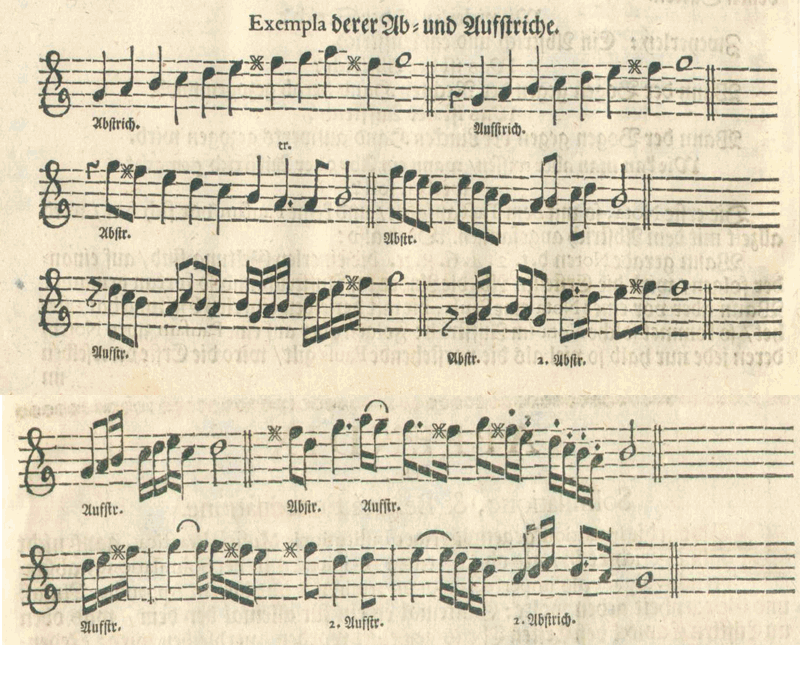A Timeline history of the Violin Bow - from c. 1600 - 1800
... the sources in detail ...
Georg Falck (c. 1630 -c. 1689)
Idea boni cantoris (Nürnberg, 1688)
There is a copy of this in the Bayerische Staatsbibliothek - with any luck this link will take you there. If not, you can search for it, the call number is: 4 Mus.th. 450
Falck's Idea boni cantoris is essentially a singing treatise (with a section on instrumental playing) directed at 'music-loving youth'. The whole is written in a rather quaint question and answer format. (e.g. "With how many strings is a violin fitted? - Generally and customarily with four ...") In his section on the violin, he describes how to hold the violin, and then proceeds to the bow thus:

What should the beginner do with the right hand?
Above all he must learn to grasp and hold the bow correctly, such that the right thumb slightly presses the hair next to the frog so that the hair, well drawn, achieves a full stroke and sound from the strings. Next, he must grasp and hold the wood of the bow between the two front joints of the fingers. The strokes should be according to the value and length of the notes long, full, and even on the strings, neither too near the bridge, nor too far from it. Coloraturas and rapid little runs should be made with strokes near the point of the bow, where the bow is light.
Above all he must learn to grasp and hold the bow correctly, such that the right thumb slightly presses the hair next to the frog so that the hair, well drawn, achieves a full stroke and sound from the strings. Next, he must grasp and hold the wood of the bow between the two front joints of the fingers. The strokes should be according to the value and length of the notes long, full, and even on the strings, neither too near the bridge, nor too far from it. Coloraturas and rapid little runs should be made with strokes near the point of the bow, where the bow is light.
This last point - "Coloraturas and rapid little runs should be made with
strokes near the point of the bow, where the bow is light" - is, I think, of great import. We read this also in Bismantova, 1677 - "passaggi [diminutions], which should be played at the point of the bow, with a short stroke”, and also in Roger North's description of Matteis - "...and he touched his devision with the very point;"
He also gives a series of examples demonstrating the order of up and down bows. This is in principle the same as the other tutors from this time (Herbst, Bismantova, Playford et al), adjustments being made where necessary to ensure a down bow on the main beats.

The only thing that is confusing is his comments about the dot:
For triple time, Falck discusses the three common options:
1. down-up-down | down-up-down etc
2. down-up-up | down-up-up etc
3. as it comes
And then he suggests that, in the end, as long as the music is not deformed, and sounds good, it doesn't matter which you do - "indeed, everything is fine and good if the strokes follow each other beautifully";


"Alle Noten die Puncta hinter sich haben sollen in Abstrich gemacht werden bevorab wann die auf den Punct folgende Nota mit demselben gleiches valors ist."
"All notes which have a dot behind [sic] them should be played with a downbow, especially when the following note has the same value"
"All notes which have a dot behind [sic] them should be played with a downbow, especially when the following note has the same value"
I have seen suggestions that he means the notes with staccato dots should all be played with a down bow (which would be a very surprising stroke to find suggested in such a beginners tutor). But I think this arises from a mis-translation. Actually, "mit demselben gleiches Valor" must refer to the Punct, not the Nota. So, "all dotted notes should be played with a downbow, especially when the following note has the same value as the dot" This lines up with what Bismantova amongst others also says, that a dotted note (ie, a longer note in the context) should be played with a down bow.
For triple time, Falck discusses the three common options:
1. down-up-down | down-up-down etc
2. down-up-up | down-up-up etc
3. as it comes
And then he suggests that, in the end, as long as the music is not deformed, and sounds good, it doesn't matter which you do - "indeed, everything is fine and good if the strokes follow each other beautifully";
